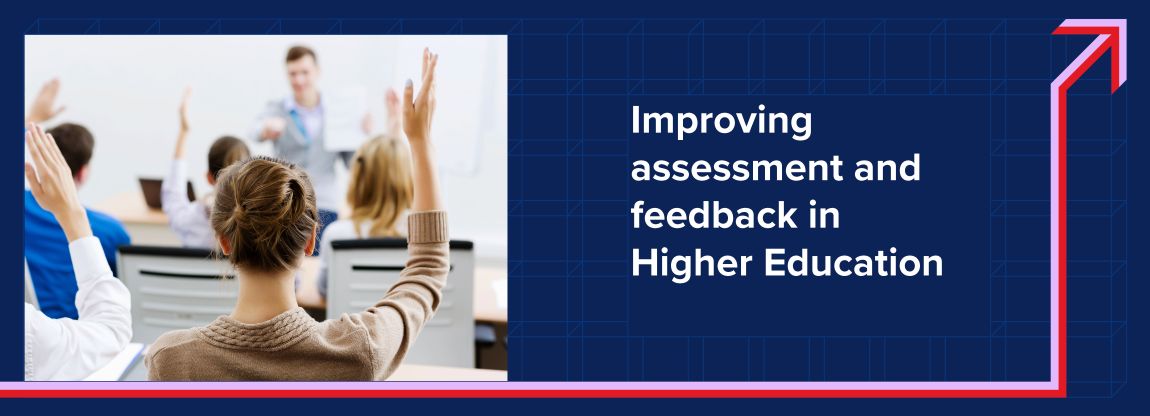Improving assessment and feedback in Higher Education
Improving assessment and feedback in Higher Education
Instructors in Higher Education are often looking for ways to enhance assessment and feedback methods for students, particularly in an ever-changing educational landscape. We’ve interviewed Angela Short, Doctor of Education and lecturer at Dundalk Institute of Technology, to gather some key ideas on how traditional assessment and feedback methods in Higher Education can be improved.
Shifting the focus from delivering content
"What is of value is how you test the student’s understanding through interaction in the classroom"
One of the key considerations surrounding Higher Education today is the role that instructors play in student education. In an environment where content is more accessible than it ever has been, instructors should shift their focus away from delivering content towards showing students how to apply it.
“Content is free,” Angela reminds us, and students can cover key points outside of class - “what is of value is how you elaborate on those points and how you test the student’s understanding through interaction in the classroom.”


Research on student engagement shows the importance of students understanding the relevance of what they are learning. In line with this finding, Angela tends to use class time as an opportunity to highlight real-life examples so that students can apply their theory. The classroom, in her view, should “provide something extra that allows them to access the learning” and ensure “that they'll be able to use it in a different context.” This also links to student success in assessment, as many examinations focus on students demonstrating an ability to apply their theory, as well as being an important skill for employability.
So how can instructors ensure that students cover content outside of class? “This is where the McGraw Hill Connect system is so useful for me,” Angela explains, “because it allows me to assign content and personalisation of content.” Using Connect, Angela can track students’ progress with core theory outside of the classroom - freeing up class time to delve deeper.
Part of improving upon traditional assessment methods, therefore, is remembering that student interaction in class is an effective way of testing understanding and preparedness.
Find out more about how Connect frees up class time for this here.
Rethinking assessment
"Why does assessment have to be time-based?"


Another important mindset shift that Angela outlines is moving from assessing what students don’t know to what they do. A lot of the traditional notions around assessment, for instance, that they should be timed, summative and essay-based, do not align with the concept of competency-based education.
“Why does assessment have to be time-based?” Angela asks. “If we want to know what students can do, why should we have them take a terminal exam, on one day of the year, to account for 70% of what they know?”
Angela advocates for continuous assessment involving multiple attempts, within deadlines, mirroring the sort of learning students are likely to encounter in the world of work. “Multiple attempts at a module shows practice and dedication,” Angela points out, and the “value in practice” is not lost upon employers. If a student learns how to do something successfully, why should the number of attempts that got them there matter? To encourage continuous effort, Angela’s modules remain open even after a deadline has passed, though students completing it late will not receive marks.
This type of continuous assessment also helps to prevent cheating, as, rather than being able to buy an essay, students on Connect receive algorithmic questions – meaning everyone gets different problems with every attempt. Instructors can also expand on this with the use of games and simulations to test students, bringing real-world examples into the mix. “When you introduce a game aspect,” Angela says, “you're tapping into, I think, the natural human need to strive and do better.”
Read more about the role of gamification in continuous assessment here.
Quick tricks for feedback
"Feedback is only useful if the student can understand how they might act upon it"
Giving effective feedback can often be a struggle for university teachers, especially when there are so many other demands upon their time.
It nonetheless remains an important consideration, particularly because, as Angela points out, “feedback is only useful if the student can understand how they might act upon it.” One helpful consideration for both instructors and students, therefore, is to “give the student a self-assessment schedule.”


“Ideally they should understand what the standard looks like and that's why an assessment rubric is important,” says Angela, so that “you explain how this piece of work is going to be assessed.” Once students understand what is needed, they can self-regulate their own work and apply generic feedback more easily, particularly when drafting and redrafting assignments.
One of Angela’s main doctoral findings is that student engagement is relational and shouldn’t be thought of as just the student’s jurisdiction. When giving feedback, even simple things make a difference – “that little bit of personalisation is so important because if you know their name, then they’re likely to ask a question” Angela points out. Even with large cohorts, producing video content of feedback can add a personal touch that isn’t time-consuming - “because students generally make the same mistake, you can do it in a screencast.” And, of course, regular algorithmic assessments and the use of games are great ways to automate continuous feedback for students on their progress.
If you want to explore further, why not read our study on how Dundalk Institute of Technology has leveraged assessment and automatic feedback in Connect to improve student performance? You can find it here.

